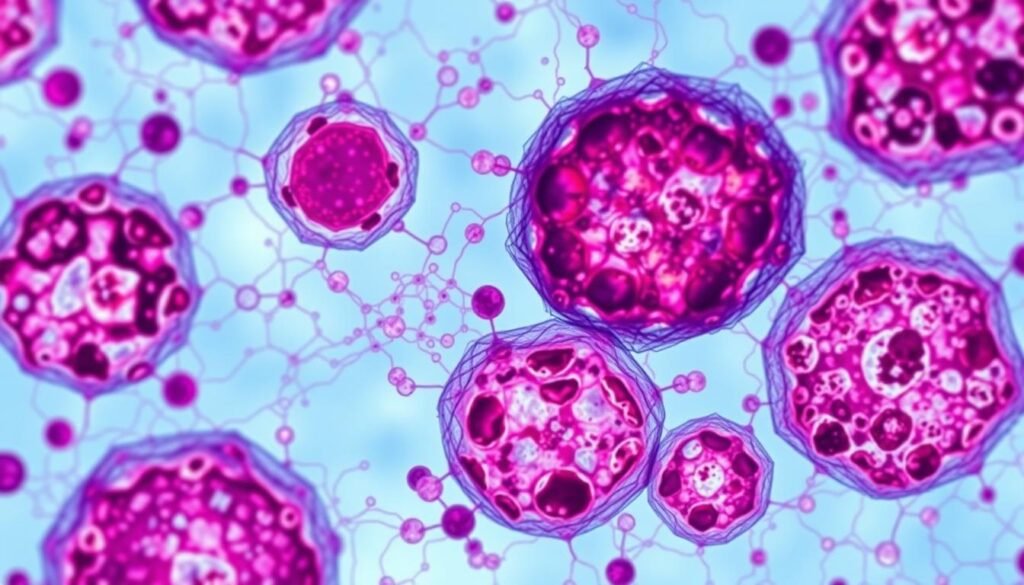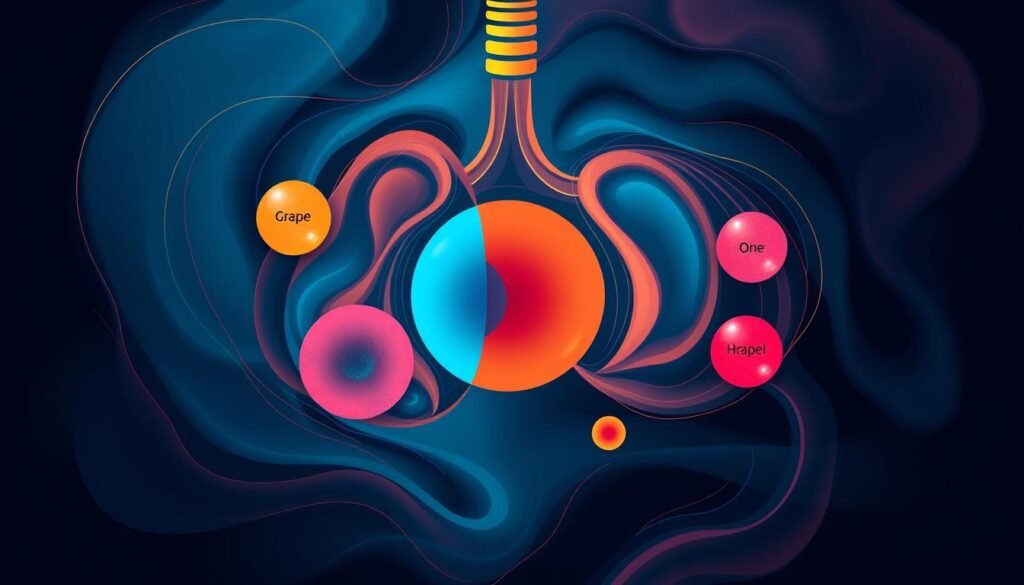Did you know chemotherapy is key for treating small cell lung cancer, with a high success rate? It uses strong drugs to kill quickly growing cancer cells, offering hope to many. As thousands in the U.S. face lung cancer yearly, knowing the chemo for lung cancer options is crucial for patients and caregivers.
This article explores lung cancer treatments, with a focus on chemotherapy. It covers the purpose of chemo, how it works, and the common drugs used. You’ll understand the chemo options available for lung cancer. The text also looks at treatment effects, side effect management, and alternative options. Plus, it offers insights into treatment schedules and resources for support. This information helps those dealing with lung cancer make informed decisions.
To learn more about chemotherapy’s role in fighting lung cancer, visit how chemotherapy attacks lung cancer cells.
Key Takeaways
- Chemotherapy is vital for treating both small and non-small cell lung cancers.
- The treatment can be given through shots or pills, suiting different patient needs.
- Combining chemo with immunotherapy is highly effective for advanced lung cancer.
- Chemo cycles usually run three to four weeks, tailored to the patient’s plan.
- Managing side effects well is important for a good life during treatment.
- Support resources, like groups and online platforms, provide help and a sense of community.
Introduction to Lung Cancer
Lung cancer is a top cause of cancer-related deaths in the United States. It often grows over many years and shows various symptoms, making early detection key. Signs like a persistent cough, chest pain, breathlessness, and losing weight without trying are common.
Knowing about lung cancer stages helps find the best treatment. There are two main kinds of lung cancer: non-small cell (NSCLC) and small cell (SCLC). NSCLC is more common but grows slower than SCLC, which is rarer and spreads quickly. Depending on the type and stage, treatments can include surgery, chemotherapy, radiation, or targeted therapies.
Smoking, radon exposure, and having family members with lung cancer are major risk factors. Focusing on prevention can greatly lower the chances of getting this serious disease. Many lung cancers, especially those from smoking, can be prevented. Taking steps to avoid risks can lead to better health outcomes and fewer deaths from lung cancer.
Understanding Chemotherapy and Its Purpose
Chemotherapy is key in fighting lung cancer. It targets and kills fast-growing cancer cells. You can take it as a shot or pill. This makes it flexible for different lung cancer cases. It can shrink tumors before surgery, kill leftover cancer cells after, or ease symptoms in late stages.
Some patients start chemotherapy right after finding out they have cancer. This treatment can last years. It usually goes in cycles, three to four weeks long. For tough cases, patients might go through four to six cycles. Amazingly, after about 18 months, some achieve complete remission, showing how effective this can be.
Of course, chemotherapy comes with side effects. Patients often lose hair, feel sick, and have skin problems. Knowing how you react to treatment helps find ways to cope better.
There are now more ways than ever to treat lung cancer. Alongside chemotherapy, doctors are using targeted therapies and immunotherapies. These new treatments give patients tailored options. Groups like Lung Foundation Australia offer support. They even have a Lung Cancer Support Nurse to help you understand your treatment options.
Chemo for Lung Cancer: Treatment Goals and Strategies
Chemotherapy is key in treating lung cancer. The goals change depending on the cancer stage and type. For early-stage lung cancer, doctors may use it to shrink tumors before surgery. This makes surgery more likely to succeed.
After surgery, chemotherapy helps kill any left-over cancer cells. This lowers the chance of cancer coming back. In late stages, it aims to make symptoms easier to handle. This is for patients with a tougher outlook.
Doctors plan treatment based on a person’s health and their cancer. They may use different chemo drugs together for the best results. Here is a table showing how chemotherapy works for lung cancer:
| Treatment Type | Objective | Example Regimens |
|---|---|---|
| Neoadjuvant Therapy | Shrink tumors pre-surgery | Cisplatin + Pemetrexed |
| Adjuvant Therapy | Eliminate remaining cancer cells | Carboplatin + Paclitaxel |
| Palliative Care | Symptom relief in advanced cases | Gemcitabine + Nivolumab |
Knowing how well lung cancer treatment works is important. Some people do better with certain treatments because of their genes. Others might get platinum-based chemotherapy first, based on their tumor.
New treatment options keep coming up. Things like immunotherapy and ongoing care are changing lung cancer care. This brings hope for better survival and quality of life for patients.
Types of Lung Cancer
Lung cancer is mainly divided into two key types: small cell lung cancer and non-small cell lung cancer. Knowing the difference is key for treatment and predicting outcomes.
Small cell lung cancer (SCLC) makes up a smaller part of lung cancer cases. It grows quickly and tends to spread fast, needing strong treatment like chemotherapy right away. It’s important to act fast with SCLC to control its spread.
On the other hand, non-small cell lung cancer (NSCLC) is far more common. It accounts for about 80-85% of lung cancer cases. This group includes several types:
- Adenocarcinoma: This is the most common NSCLC, often found in non-smokers. It usually starts in the outer lung areas.
- Squamous Cell Carcinoma: This type starts in the middle of the lungs, near the airways. It’s often related to smoking.
- Large Cell Carcinoma: This cancer can grow and spread faster than the other NSCLC types.
There are also rare lung cancer types like mesothelioma, which is tied to asbestos exposure, and tumors in the mediastinum. These can range from harmless to dangerous and are found in the area between the lungs.
| Lung Cancer Type | Percentage of Cases | Characteristics |
|---|---|---|
| Non-Small Cell Lung Cancer (NSCLC) | 80-85% | Includes adenocarcinoma, squamous cell carcinoma, and large cell carcinoma. |
| Small Cell Lung Cancer (SCLC) | 15-20% | Fast-growing, often spreads rapidly. |
| Mesothelioma | ~5% | Associated with asbestos exposure. |
| Mediastinal Tumors | Rare | Can be benign or malignant, affecting lung separation area. |

How Chemotherapy Works
Chemotherapy is key in fighting lung cancer. It targets and stops cancer cells from growing. The chemotherapy mechanisms aim to destroy quickly dividing cells. This is something cancer cells do more than normal cells. Lung cancer treatment usually involves chemotherapy administration through shots or infusions. This way, the drugs go into the bloodstream and attack cancer cells everywhere in the body.
Chemotherapy drugs act in different ways to stop cell growth. Some damage the cell’s core, while others block necessary chemical actions. Treatments for small cell lung cancer (SCLC) often use Cisplatin plus Etoposide or Carboplatin plus Etoposide. The choice of drugs depends on the type of cancer a patient has.
The treatment goes in cycles, each lasting three to four weeks. There’s a rest period between cycles to let the body heal. Generally, a patient goes through four to six cycles. After that, doctors might suggest continuing with immunotherapy drugs. They do this especially if the patient is doing well.
Patients should know about possible side effects of chemotherapy. These can include nausea, hair loss, peripheral neuropathy, and kidney issues from drugs like Cisplatin. It’s critical for patients to tell their doctors about any side effects right away. This helps manage bad reactions and possibly change the treatment plan. Doing so makes the chemotherapy experience safer and more effective.
When is Chemotherapy Recommended?
Chemotherapy plays a key role in lung cancer care. It’s recommended at various stages of disease. For both non-small cell lung cancer (NSCLC) and small cell lung cancer (SCLC), when to start chemotherapy can greatly impact results.
After surgery, chemotherapy can help kill any remaining cancer cells. This is common for stage 2 or 3A lung cancer. It helps prevent the cancer from coming back. If the cancer is more advanced, chemotherapy might be the main treatment. It’s often combined with radiation therapy.
Doctors frequently use a mix of drugs for better results. For SCLC, etoposide with cisplatin or carboplatin is a typical choice. For NSCLC, treatments often start with drugs like cisplatin and carboplatin. They might add drugs such as pemetrexed or taxanes.
Some patients join lung cancer clinical trials during their therapy. These trials test new treatments and drug combinations. They offer hope for better outcomes, especially when standard treatments fail.
Handling side effects is crucial since chemotherapy can cause nausea, fatigue, and neuropathy. Treatment might need adjustment. This could mean changing the chemotherapy dose or adding other meds. Clinics also offer supportive care and nutrition advice to ease treatment difficulties.
Common Chemotherapy Drugs for Lung Cancer
Chemotherapy is key in treating lung cancer. It uses drugs to kill cancer cells effectively. The most common ones are cisplatin, carboplatin, paclitaxel, and pemetrexed. These chemotherapy drugs can be used by themselves or together. This depends on the patient’s needs and the lung cancer type.
For example, platinum-based drugs like cisplatin or carboplatin are often paired with others like gemcitabine or docetaxel. This mix is mainly used in non-small cell lung cancer (NSCLC). The right combo of lung cancer medications makes a big difference in success.
In small cell lung cancer (SCLC), making up about 15 percent of lung cancers, chemotherapy is the main treatment. Patients get these drugs through an IV, usually every three weeks. Side effects can include tiredness, hair loss, and feeling sick. These need careful control during treatment.
As the cancer gets worse, doctors might add targeted therapies or immunotherapy to chemotherapy. This blend is aimed at improving how well treatments work. It’s especially for advanced cancer that has spread.
Knowing about different chemotherapy options helps patients make good choices about their care. If you want to learn more about the drugs and their combinations, click here.
Understanding Chemotherapy Cycles
Chemotherapy involves administration in cycles, often lasting 3 to 6 months. These periods depend on the lung cancer type, stage, and chosen drugs. The goal is to attack the cancer effectively.
Patients typically go through 4 to 8 cycles of treatment. Each cycle includes a period for receiving chemo and chemo intervals for recovery. The treatment may be given weekly or every 2 to 4 weeks. This schedule targets cancer cells at different growth stages while allowing healthy cells to recover.
Before starting a new cycle, doctors check the patient’s health and side effects. They use blood tests and health assessments. This helps them tailor the chemotherapy to the patient’s changing needs.
Chemotherapy sometimes pairs with other treatments, like radiation. Adjuvant therapy helps prevent cancer’s return post-surgery. Neo-adjuvant therapy aims to reduce tumors before surgery. Together, they improve treatment success.
For more info, patients can look at resources about chemotherapy for different lung cancer stages. Knowing about treatment cycles helps in discussing options with healthcare providers.

Managing Chemotherapy Side Effects
Chemotherapy side effects can vary a lot, affecting different parts of a patient’s health. Symptoms often include fatigue, hair loss, nausea, and appetite changes. These issues happen because chemotherapy aims at cancer cells that grow fast. But, it also hits normal cells that grow quickly.
It’s key to handle these side effects well to make life better for patients. For example, people may feel very tired but getting enough rest and eating right can help. If someone feels sick to their stomach, doctors can give medicines to make it better. Some patients even find relief from nausea through acupuncture, a type of traditional therapy.
Knowing how to deal with side effects is vital for good cancer care. Talking often with health care teams helps adjust treatments. This can make side effects less severe and help patients stick with their therapy.
- Ongoing infections due to decreased white blood cell counts
- Hair loss requiring preparation, such as exploring wigs or head coverings
- Loss of appetite, often managed through small, frequent meals
- Anemia, which may necessitate intervention or blood transfusions
- Peripheral neuropathy manifesting as numbness or tingling in extremities
- Changes in liver function tests necessitating regular monitoring
Many patients look for more advice on handling chemotherapy side effects. Knowing what might happen helps in getting ready and dealing with it. Going to the emergency room for serious side effects is still a big issue. It shows why we need good ways to prevent these problems.
Treating side effects should be custom-made. It’s important to know the special problems each patient has. Working closely with doctors makes sure the right help is given. This makes the cancer treatment experience better for patients.
| Side Effect | Management Strategy | Note |
|---|---|---|
| Fatigue | Ensure adequate rest and nutrition | Exercise can help boost energy |
| Nausea | Anti-nausea medications | Small, frequent meals recommended |
| Hair Loss | Consider wigs or other head coverings | Cold caps may reduce hair loss |
| Infections | Regular blood tests for white cell counts | Practice good hygiene |
| Peripheral Neuropathy | Physical therapy and pain management | Communication with healthcare provider |
| Loss of Appetite | Frequent, balanced meals | Focus on high-calorie foods |
Alternative Lung Cancer Therapies
Lung cancer therapies include not just chemotherapy but other methods too. Many patients look into alternatives to go along with the usual treatments. Among these are immunotherapy and targeted therapy, which are making a difference in fighting cancer.
Adding treatments like yoga can do wonders. It increases strength, energy, and mental wellness, especially for those with advanced cancer. Acupuncture is another choice, helping ease nausea from cancer treatments.
Some choose guided imagery or visualization. These practices might lessen depression and lift spirits during cancer care. Using these methods may better one’s life. But, solely relying on them could cut survival rates, warnings show.
Before trying any alternative therapies for lung cancer, talking to a doctor is key. One must check how effective these are and any negative effects. It’s important to see how they mix with usual care. Many alternative options, like herbal remedies, don’t have strong proof they work against cancer.
Finding out about treatment options and if insurance covers them matters a lot. It shapes the financial and emotional journey of cancer care. Choosing treatments is a team effort with your doctors to get the best result.

Lung Cancer Support Groups and Resources
Support systems are crucial for those facing lung cancer. Organizations like CancerCare and the American Cancer Society offer many cancer care resources. These resources are designed for patients and their families. They range from workshops to emotional support, making them very valuable.
The LUNGevity Lung Cancer Helpline, at 844-360-LUNG (5864), connects callers with trained specialists. CancerCare runs an online Lung Cancer Caregiver Support Group. This allows caregivers to share experiences. They also offer Coping Circle Workshops and Connect Education Workshops. These provide expert insight on cancer topics.
Meal assistance is key. The Magnolia Meals at Home program delivers nutritious meals to patients, helping them eat well during treatment. Support groups, led by oncology social workers, create caring spaces for sharing experiences and challenges.
The American Cancer Society offers more help with their 24/7 helpline at 1-800-227-2345 and ACS CARES™. These offer detailed info and one-on-one support. Their Road To Recovery program provides transportation for patients needing help getting to appointments.
| Resource | Description | Contact Information |
|---|---|---|
| LUNGevity Helpline | Support and information for lung cancer patients | 844-360-LUNG (5864) |
| CancerCare Support Groups | Online groups led by social workers for patients and caregivers | Visit CancerCare website |
| Magnolia Meals at Home | Meal delivery program for patients in select locations | Visit CancerCare website |
| American Cancer Society | 24/7 cancer helpline and various support programs | 1-800-227-2345 |
| Road To Recovery | Transportation assistance for cancer patients | Visit American Cancer Society website |
Joining lung cancer support groups gives people the strength to face their treatment. These patient support tools help maintain hope and bond with others in similar situations.
Conclusion
Understanding chemotherapy for lung cancer is key to knowing your treatment options. Chemotherapy is still a main treatment, even though new therapies exist. It helps improve life quality and gives hope to those with advanced disease.
People with lung cancer face many challenges. Knowing about chemotherapy helps them make informed choices. It’s vital to work closely with doctors. This ensures patients know their options and can find helpful resources.
Lung cancer is a major health issue, with many new cases and deaths expected in 2024. Keeping up with chemotherapy and treatment information helps patients. Early action is critical. It leads to better outcomes and personalized care plans for recovery.